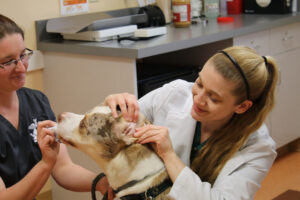By: Dr. Jackie Connolly, Associate Veterinarian for Humane Veterinary Hospitals
Imagine you are a cat; living your best life on a sunny windowsill, thinking about when your human’s are going to bring you your next meal. Suddenly your owner places you in an unfamiliar carrier, puts you in a moving vehicle and brings you to a place where they touch your ears, look in your mouth and poke you with needles. Scary right? Now imagine you are a dog, about to go for a car ride. You are so excited to go to the park, but then your owner pulls up to the scary building where they trim your nails. You hate having your paws touched, especially since a few times the nail trim really hurt! Your owner pulls you by the leash and through the door as you try your hardest to pull in the other direction. When the nurse goes to pet you, you start to urinate because you are so scared of what they might do.
For many years we did not consider the emotional health of our pets, even in the veterinary setting. Now, we know that we can do so much better to keep our patients free from anxiety and stress during their visit. Through open communication, proper planning, and the use of toys and treats, we at Humane Veterinary Hospitals know how to make your pet’s experience at the veterinarian a good one.
Identifying Fear and Anxiety
Since our patients cannot speak to us, we have to rely on behaviors to identify fear and anxiety. When dogs and cats are stressed, they show many nonverbal pleas for help before reaching the point of ‘fight or flight.’ These behaviors may include shaking, tucking their tail, ears back, tense body, enlarged pupils, showing the whites of their eyes, yawning, or avoidance. As with humans, fear may not always be rational and once our pets feel they are in danger, it can be difficult to tell them everything is going to be ok. If my patients are running from me, urinating on themselves, or trying to bite, continuing to push them is the worst thing I could do.
Luckily, our animal care team can identify these behaviors, as well as common stressors, and take action before they become a problem. We can also use rewards and distractions to keep our patients calm in uncomfortable or painful situations.
Communication
The first phone call you make to the veterinarian is the best time to voice any behavioral concerns you have with your pet. This is especially important if your pet has certain “triggers” for fear such as other dogs, men, loud noises, carriers, stainless steel tables, nail trimmers, etc. Some pets may even have a history of lunging, biting, and scratching (the ‘fight’ response of fear) and may require sedatives for their visit. By discussing your pet’s behavioral needs with our receptionist or nurse, we can make accommodations such as, scheduling at a less busy hour, or for a longer appointment slot. We can also address these behavioral concerns at the time of the appointment to make sure your next visit is even better!
Communication is a two way street. Our team will make it a priority to explain to you what needs to be done or what cannot be done given your pet’s emotional state. Our staff are trained in animal behavioral and body language, allowing us to identify when your pet is feeling stressed or anxious. The goal is to identify what works best for the individual patient and to make the experience positive.
Planning for Your Visit
Fear and stress in our patients may start as soon as they see their carrier or are put into the car. As we know from dealing with stress in our own lives, it can become exponentially worse the longer we are in the situation. If a patient enters our hospital already stressed, this makes it even harder for us to ensure a positive experience for them. The good news is that there are things owners can do at home to help.
It helps to keep our canine patients retrained during transport so they do not become car sick or feel unstable. Non slip liners can be used for their comfort. Training your dog to sit calmly in the car before making a trip to the vet’s office can also be very helpful. The use of classical music, phermone sprays, and puzzle toys can also help keep your dog distracted and free from stress.
Cats are very sensitive to loud noises and changes in their environment, especially new smells and people. It is best practice to get them used to their carrier as a kitten, and leave it out at all times. Though the use of pheromone sprays (Feliway), toys, and treats, the carrier can be made into a ‘safe space.’ I recommend my clients purchase a hard carrier that opens easily from the top. This allows our patients to feel secure, and makes it easier for us to do our examination where they feel safe. Keeping a soft, clean blanket in the carrier and placing a towel over the carrier can keep our feline friends comfortable and allow them to hide. Owners should never force cats into carriers or attempt to wrangle a cat who is biting or scratching. Always call your veterinarian if you are having trouble, so we can figure out a new plan that works.
The Power of the Food Reward
At the Humane Veterinary Hospital, we use peanut butter, squeeze cheese, hard treats, whipped cream and even baby food to keep your pet happy. Sometimes this means putting peanut butter all over the wall during an exam, putting treats on the scale, or putting cheese in a muzzle. This allows us to do a physical exam, get a blood sample, or treat an ear infection without having to use heavy restraint or cause the fight or flight response. In some patients anxiety medications or sedatives can be used to improve your pet’s overall experience. We also use pheromone sprays, towel wraps, and classical music. Our nurses and doctors will record what works and what doesn’t work for each individual patient including their favorite foods, places they don’t like being touched, and if they do better with certain staff members. We also offer ‘happy visits,’ or visits that allow you to bring your pet in as a training exercise, where we shower them with food and love and avoid any of the scary stuff. By doing this we can make sure that at each appointment, they are as excited to see us as we are to see them.
Focusing on keeping our patients free from fear while at our hospital is one more way we can keep them healthy. It allows us to do a more thorough examination, and get diagnostic procedures done in a timely manner. We love when they greet us with tail wags and kisses and are committed to helping you make that happen.


 nary Hospital parking lot, but it’s made sense to move them to various locations, just as we did with our original vaccine clinic model. Each new location has the potential to expand our audience, which is just what we want: the more people that know about the Drive-in Clinics, the better! Different spots also mean that we get the chance to create positive new relationships with other businesses and organizations in the community, and that always opens opportunities. For example, we’ll be in the parking lot of Nightclub Reverb for one of the October clinics (thanks, Reverb!). Nightclubs previously had been overlooked, not coming to mind as an obvious shelter or vet hospital connection. This gave us the chance to ask, “why not?!” Their parking lot is a great space for our Drive-in Clinic, plus their neighborhood and their general audience are pet owners too!
nary Hospital parking lot, but it’s made sense to move them to various locations, just as we did with our original vaccine clinic model. Each new location has the potential to expand our audience, which is just what we want: the more people that know about the Drive-in Clinics, the better! Different spots also mean that we get the chance to create positive new relationships with other businesses and organizations in the community, and that always opens opportunities. For example, we’ll be in the parking lot of Nightclub Reverb for one of the October clinics (thanks, Reverb!). Nightclubs previously had been overlooked, not coming to mind as an obvious shelter or vet hospital connection. This gave us the chance to ask, “why not?!” Their parking lot is a great space for our Drive-in Clinic, plus their neighborhood and their general audience are pet owners too!